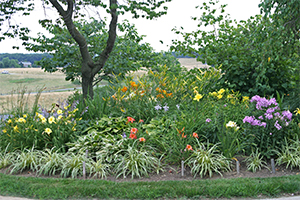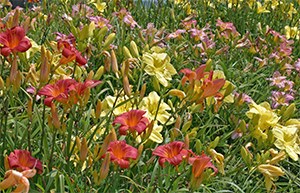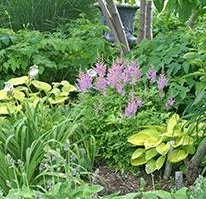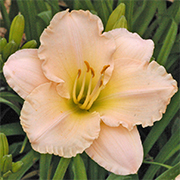As the spring blossoms of iris and peonies fade, a host of beautiful summer bloomers fills in to paint a colorful landscape in the
Viette gardens!
 |
| Daylilies and phlox bloom in one of the front berm gardens at Viette's. |
 |
Beautiful blooming daylilies.
Peak daylily bloom for our gardens is in mid-July.
|
|
|
Plant of the Month
|
| Beautiful bold Echinacea brighten the summer garden |
Echinacea purpurea
Coneflower
Rediscover Echinacea!
Big, Bold Coneflowers
Echinacea purpurea is a wildflower native to the United States that has been extensively hybridized in recent years. This robust perennial with the common name Purple Coneflower is anything but purple anymore! Incredible new colors are showing up year after year. These beautiful new cultivars retain all the outstanding characteristics of their vigorous wild ancestors, being tough, long-lived, long blooming, and drought resistant.
|
|
| Echinacea 'After Midnight' |
Butterfly Magnets!
Coneflowers have interesting shuttlecock-shaped blooms with bristly orange-bronze central cones that provide wonderful landing pads for butterflies. The sturdy stems never need staking and the vibrant blooms make long-lasting cut flowers for fresh and dried arrangements.
Coarse, dark green foliage maintains a compact, clumping form that typically spreads to 18" to 24" wide. The blooms, which are irresistible to butterflies, begin in early summer and continue to frost. Coneflowers grow best in full sun or light shade in average soil and are excellent for naturalizing.
|
|
|
Butterflies flock to coneflowers
|
Exciting Bold Colors!
The gorgeous 'Big Sky Sundown' displays vivid electric orange petals with a bold rusty central cone providing dazzling color from midsummer to frost.
Another beautiful orange cultivar is the large flowered 'Tiki Torch'. These bright orange coneflowers are irresistible to butterflies and gardeners! Combine these with the bright yellow blooms of Echinacea 'Big Sky Sunrise' and your summer garden will never be more vibrant.
|
|
|
One of the pale yellow cultivars
|
Traditional Coneflowers
If you are interested in more traditional purple coneflowers,
Echinacea purpurea 'Magnus' is a great choice for the sunny garden. This beautiful purple cultivar was the Perennial Plant Association 'Plant of the Year' in 1998 and is still one of the most popular perennials sold today.
'Kim's Knee High' is another purple form with vivid magenta petals and a deep rusty center. This cultivar is somewhat shorter than other coneflowers growing to an average of only 20" tall compared to the more typical height of 30" to 36".
The beautiful white form,
Echinacea 'White Swan' has drooping white petals and a brown central cone.
All of these wonderful coneflowers are excellent for attracting butterflies.
|
| Did You Know? |
Andre's Four Points for a Perfect Lawn
1. Cut the grass high
Andre suggests setting your mower blades to cut the grass no lower than 3". Grass mowed high develops extensive root systems and will shade out and compete better with broadleaf lawn weeds.
2. Keep blades sharp
Lawn mower blades should be sharpened several times during the season. When your mower blades are razor sharp, they slice off the grass cleanly. Dull blades tear and damage the grass blades leaving the lawn looking scorched and may lead to disease problems.
3. Water properly
Deep, slow watering (putting down 1 1/2" water each time) every 7-10 days leads to healthy lawns with deep root systems.
4. Go Organic!
Use organic fertilizers such as Espoma Organic Lawn Food or Milorganite to fertilize your lawn. These organics release their nutrients slowly over time so you only need to apply them twice a year - once in spring and again in fall.
|
|
Did You Know?
|
Avoid Spray Damage to Your Plants!
Pests and disease are an unavoidable part of summer in the garden and many gardeners will be out in the vegetable and flower garden with their sprayers and dusters trying to combat the worst of the problems by applying insecticides and fungicides.
However, when you are spraying in the heat and humidity of the summer, there are some important tips to keep in mind in order to avoid injury to your plants: Water the day before you plan to spray.
Spray injury is much more likely when plants are stressed due to lack of water. When your plants are well watered, their cells are turgid and the foliage is much less likely to suffer from chemical burn.
Spray during the cooler part of the day.
Spray injury can occur if you spray in the bright sun during the heat of the day because the combination of the heat and the chemicals can burn the foliage. Most chemicals should not be sprayed when the temperature is above 85?F or 90?F. During the summer, the best time to spray is in the early morning or in the evening.
This also helps protect the bees and other pollinators if you are spraying an insecticide.
Always read and follow the label directions when spraying any pesticide, herbicide, or fungicide! |
|
Join Our List
|

|
| Gardening Questions? |
Listen to Andre on the radio every Saturday morning from 8:00-11:00 on
"In the Garden
with Andre Viette"
|
Viette Discussion Board
|
Having trouble
getting through on
the radio?
Visit our
Discussion Board for answers to your gardening questions. Use the convenient search key to see if we have already addressed your problem!
Don't see the answer? Post your question!
It's EASY, just register
as a member.
Don't forget to provide your city and state so we are better able answer your question.
|
|
|
|
Tip of the Month
|
Beware the PESTS of Summer
Summer is here and with it come many garden pests that can wreak havoc on your flowering plants and vegetables. Having the ability to identify problem insects in the garden is a big step toward overcoming them. Learn to recognize the telltale signs left by different insect pests and discover how to control them before it's too late!
|
|
|
Spider mites on their web. Notice the mottled yellow foliage from feeding damage
|
Spider Mites These tiny critters are not insects but they can inflict a lot of damage to your plants despite their minute size. Spider mites are related to spiders and ticks (as are all mites) and many spin fine webs which help protect them against their natural enemies. These pests target many different plants. They are common on many perennials, roses, fruit trees, needled evergreens like spruce and juniper, and even vegetable plants and houseplants. They damage foliage by piercing plant cells with their mouth parts and sucking out the juices. This gives the leaves a stippled appearance with small yellow spots and may cause bronzing of the foliage.
If you suspect spider mites, you can confirm your suspicions by holding a sheet of white paper under a leaf or branch and sharply tapping it over the paper. This will cause the mites to fall onto the sheet of paper and you will see little dots moving around on it.
Spider Mite Control
- Spider mites thrive in hot, dry conditions and seem to especially target plants that are stressed due to drought or poor nutrition. One of the best controls is to keep your plants healthy through proper watering and feeding.
- Spraying affected plants with a jet of water will knock many off and the moisture will temporarily create unfavorable conditions for these mites.
- Bonide All Seasons Oil or Neem Oil can be sprayed on your plants to smother the mites and this is another good non-chemical means of spider mite control.
- For severe infestations, the application of a miticide may be necessary to control spider mites. Bonide Mite-X, Bonide Captain Jack's Deadbug Brew, and Bayer Advanced Natria Insect, Disease & Mite Control are listed for control of spider mites.
ALWAYS READ and FOLLOW the LABEL directions when using any pesticides.
|
|
|
Aphids clustered on the stems
of goldenrod
|
Aphids
Aphids are small, soft bodied, pear-shaped insects with piercing, sucking mouth parts. Like the spider mites, they suck plant juices causing curling and distortion of leaves and stems in a wide range of plants. In addition, some aphids are a vector for many viral diseases, spreading them from plant to plant as they feed. They also secrete a sugary substance called honeydew as they feed. A black fungus called sooty mold grows on the honeydew and is not only unsightly but slows down photosynthesis. Controlling Aphids
- A strong jet of water from your hose will usually knock them off. Repeat this as necessary.
- Spray with an insecticidal soap, Bonide All Seasons Spray Oil, Bayer Advanced Natria Multi-Insect Control, Bonide Neem Oil, Bonide Pyrethrin, or Bonide Mite-X (all listed for organic gardening)
- Spray Bonide Eight on ornamentals and edibles.
- Ornamentals can be treated with Bayer Advanced All-In-One Rose & Flower Care (DO NOT use on fruit trees, vegetables, or other food crops!).
- Ornamental trees and shrubs can be treated with Bonide Annual Tree & Shrub or Bayer Advanced 12 Month Tree & Shrub Protect & Feed.
ALWAYS READ and FOLLOW the LABEL directions when using any pesticides.
Beetles including Japanese Beetles
|
|
|
Mexican bean beetles can be devastating to bean crops.
|
There are many different kinds of beetles that are damaging to plants. Most are chewing pests that eat leaves and stems. The most common beetles that I battle in my garden are Japanese Beetles, Colorado Potato Beetles, and Mexican Bean Beetles. They chew the leaves to lace and destroy my plants and vegetables! Cucumber beetles feed on the foliage but their main threat is that they are vectors for the devastating bacterial wilt that affects cucurbits, especially cucumbers and melons. Beetle Control
- Hand picking is the safest method of control for beetles, however this is often difficult if not impossible to keep up with.
- Luckily, many different beetle species can be controlled with the same insecticides. Always check the label for the specific beetle you have.
- Bonide Beetle Killer
- Bonide Eight
- Bonide Captain Jack's Deadbug Brew (for organic gardening)
- Kill the beetle grubs that are in your lawn!
Click here for tips on killing these grubs
ALWAYS READ and FOLLOW the LABEL directions when using any pesticides.
Scale Insects
|
|
|
Euonymus scale coats a stem
|
Scale is a common insect pest of many ornamental trees and shrubs. These tiny insects take up residence on the stems and leaves and heavy infestations can cause major damage.
Scale insects feed by sucking juices from the plant with thread-like mouth parts. This causes damage to the stem and yellow stippling of the leaves. Eventually leaves can damaged enough that photosynthesis is reduced and in severe cases, leaf drop and the death of infested branches occurs. Heavy infestations may kill the entire plant.
There are two types of scale; armored scale and soft scale. Throughout most of its life cycle, armored scale (as its name implies) is covered and protected by a hard waxy shell. Soft scale has a cottony, waxy body but no shell covering their body. The tiny crawler stage that hatches from the scale eggs is the most vulnerable to pesticide treatment because they are not protected by a hard shell or waxy coating of later stages.
Controlling Scale
- Natural predators like the lady beetle do a good job at suppressing heavy infestations of scale insects.
- If the problem isn't extensive, infested branches can sometimes be pruned out but if a shrub is repeatedly infested year after year, it may be wise to remove it and replace it with a more resistant variety.
- If chemical treatment is necessary, the timing of the application is important. The best time to control scale is when they are in the crawler stage. Killing the first generation of crawlers provides the best control because at the time these hatch, the adults from the previous year have already died.
- Horticultural oil sprays are very effective in killing the crawlers. Bonide All Seasons Oil and Pure Spray Green (from the makers of Clear Choice) are good choices. It is imperative to coat every surface of the plant (all sides of the leaves and stems) in order to achieve the best control.
- Systemic insecticides such as Bayer Advanced All-in-One Rose & Flower Care and Bonide Annual Tree and Shrub also provide effective control of crawlers and will also help suppress the adult stages of the scale insect.
Thrips
|
|
|
Thrips on a daylily petal
|
Thrips are small cigar-shaped insects with long, narrow fringed wings. They are tiny and just visible to the naked eye. There are many different species and most cause injury to plant tissue. A heavy infestation of thrips can cause severe damage to foliage and even flowers and fruit as their rasping/sucking mouth parts scrape the tissue and extract plant juices.
On foliage, thrips damage appears as brown stippling on the leaf surface and when damage is more severe, the leaves may appear silvery or papery in appearance. Flower buds can become distorted and sometimes fail to open. Thrips damage on open flowers appears as dead spots, blotches, or the flowers may be discolored or deformed.
|
|
|
Thrips damage. Note how tiny they are
|
If you have thrips, sometimes you can see their little cigar shapes on the flowers or foliage but they are very small. You may also notice black specks of fecal material left on the foliage or flowers. Andre's easy way to tell if you have thrips is to shake the foliage or a flower just above a pad of white paper and see if any little cigar-shaped insects fall onto the paper.
Controlling Thrips
You should know! Even natural or organic products can be deadly to pollinators like bees. If possible DO NOT spray when plants are in bloom. If this is not possible, spray early in the morning or later in the evening when bees are less active and ALWAYS read the label! |
|
June Lectures Under the Old Apple Tree
|
Join us at the farm for these informative lectures ...
Saturday, June 13 at 1:30 pm
Container Gardens Aren't Just for Flowers!
Join our special guest Sam Harris for this amazing immersion into the art of designing beautiful container gardens. Sam is the host of the "Container Challenge" at the Philadelphia Flower Show and the Landscape Designer/Project Coordinator for Williams Brothers Tree & Lawn Service.
|
|
|
A mix of annuals, perennials, and a golden Caryopteris shrub
makes a stunning container
|
Container gardening is great with annual and perennial flowers but let's not forget shrubs! Sam will create stunning designs, giving you great ideas you can bring to your own garden! He will cover both shade and sun plants. You'll learn proper soil preparation, watering, and feeding. Along with flowers, Sam will cover boxwood, Japanese maple, hydrangea, yew, and many other shrubs that lend themselves well to container gardening. For Sam, container gardening is a year round joy! He will teach you how to make seasonal changes to your containers so that they will always look good!
Free lecture
Wednesday, June 17 at 1:30 pm
Beautiful Summer Perennials for Your Garden
Learn all about the wonderful perennials that bloom in the early summer and beyond. Andre will talk about tough summer plants which survive heat and drought conditions. He will focus on perennials with easy culture and low maintenance. Learn how to prepare your garden for summertime by choosing the best summer perennials.
Andre will take you on a personal tour of his beautiful summer gardens after his talk. See his gorgeous hosta collection and all the other wonderful summer bloomers! Free lecture
Saturday, June 20 at 1:30 pm All About Sun and Shade Gardens  What is considered sun? What is shade? How much sun can shade plants tolerate? Will sun plants grow in part shade? Learn the answers to these questions and more as Andre talks about gardening with annuals, perennials, shrubs, and trees in the sun and shade. Learn the Viettes' secrets of proper soil preparation with the best amendments, proper watering practices, planting techniques, and more. What is considered sun? What is shade? How much sun can shade plants tolerate? Will sun plants grow in part shade? Learn the answers to these questions and more as Andre talks about gardening with annuals, perennials, shrubs, and trees in the sun and shade. Learn the Viettes' secrets of proper soil preparation with the best amendments, proper watering practices, planting techniques, and more. After the talk, Andre will take you on a personal tour of the sun and shade gardens that surround the Viette Nursery. Free lecture Saturday, June 27 at 1:30 pm The June Blooming Daylilies
 The early daylilies will be in bloom! Learn all about these early bloomers and which ones are the best performers. Learn how to The early daylilies will be in bloom! Learn all about these early bloomers and which ones are the best performers. Learn how to to create your full season daylily garden, by choosing some early season bloomers. These multi-stemmed, multi-branched beauties will bloom through most of June. Combine some early-midseason bloomers with these early bloomers to extend your daylily bloom into mid July. Then add some midseason bloomers, mid-late season, and late season bloomers and presto - you have a beautiful succession of color from June through September with lovely, vibrant daylilies.
Andre will take you on a personal tour of the early daylilies and the beautiful June gardens.
Free Lecture.
|
|
Join Mark Viette at Christmas Tree Hill
|
Saturday, June 13 - 9:30 am
Christmas Tree Hill - York, PA

for an informative
gardening seminar on:
"Landscaping Your Home for a Beautiful Garden"
Mark will talk about design tips, creating garden rooms, plant spacing, proper planting, raised beds and container gardening. Renovating and making the most of your garden will be discussed. Combining the best trees, shrubs, roses, evergreens, perennials, bulbs and annuals to created garden layers will be included.
The first 50 attendees will take home a bare root Viette hybridized daylily, 'Viette's Dream' valued at $29.95.
Christmas Tree Hill is located at:
2801 South George Street, York, PA
717-741-2296
|
If you enjoy our newsletter, please pass it along to your gardening friends!
|
On the Viette's Views Blog
|
|
From the Viette's Views Archives
More on summer garden pests ...
09-26-2012
|
|
|
Snails can cause significant damage to hosta
|
"My hosta are getting eaten - there are lots of holes in the leaves ...
"I just planted four basil plants yesterday and this morning there are small holes in the leaves ...
"My lettuce leaves have lots of holes in them looking like something has been eating through them at night ...
These are just a few of the inquiries we've gotten [...] Read more ...
|
|
Join Mark on an Exciting Tour of Ireland
|
Best of Ireland Tour
Departs August 20, 2015
Join Mark Viette on this wonderful tour of Ireland!
Experience the Best of Ireland on a 12-day tour.
 Fly into historic Dublin with a city tour including the Bank of Ireland and St. Patrick's Cathedral (the largest church in Ireland). Head south with a stop at the Rock of Cashel followed by Waterford with an included tour of the famous crystal factory. Continue to Cobh, visit Blarney Castle, and perhaps kiss The Blarney Stone en route to Killarney. Fly into historic Dublin with a city tour including the Bank of Ireland and St. Patrick's Cathedral (the largest church in Ireland). Head south with a stop at the Rock of Cashel followed by Waterford with an included tour of the famous crystal factory. Continue to Cobh, visit Blarney Castle, and perhaps kiss The Blarney Stone en route to Killarney.
Drive the spectacular "Ring of Kerry," offering stunning scenery and tour Bunratty Castle & Folk Park, built in 1425. View the Cliffs of Moher; discover Galway, the Connemara region, Kylemore Abbey and the Sligo area.
Enjoy a guided tour of Belleek Pottery, visit Ulster American Folk Park, and explore The Giant's Causeway.
Your tour of the "Emerald Isle" ends in Belfast with sightseeing, including the impressive Parliament buildings, plus you'll visit the world's largest visitor experience, Titanic Belfast.
Join Mark Viette and WRVA Listeners in Ireland -
and don't forget your camera!
|
|
|